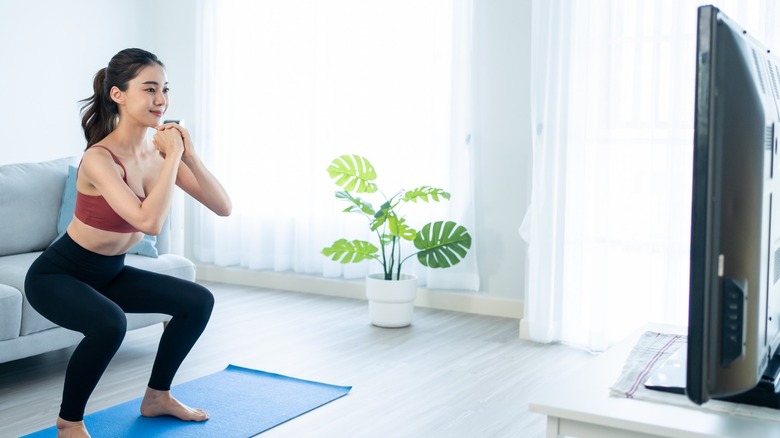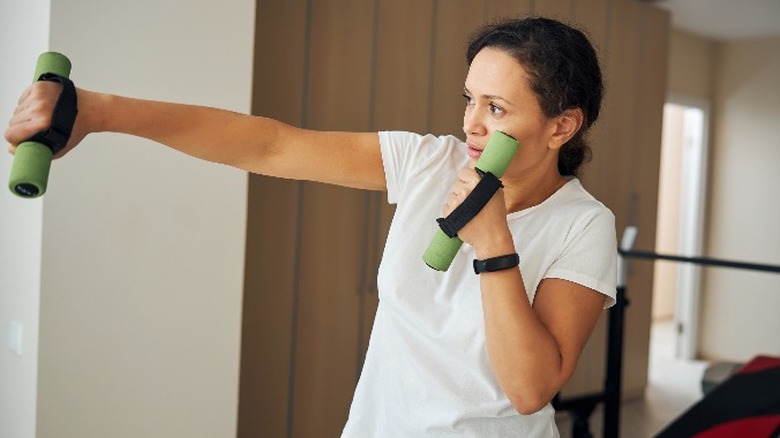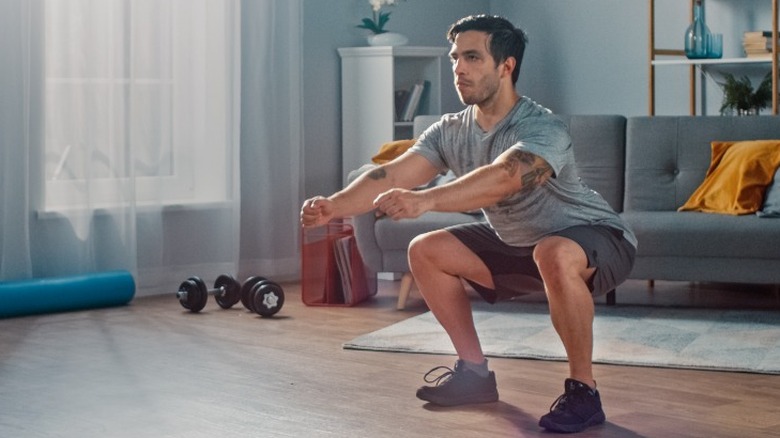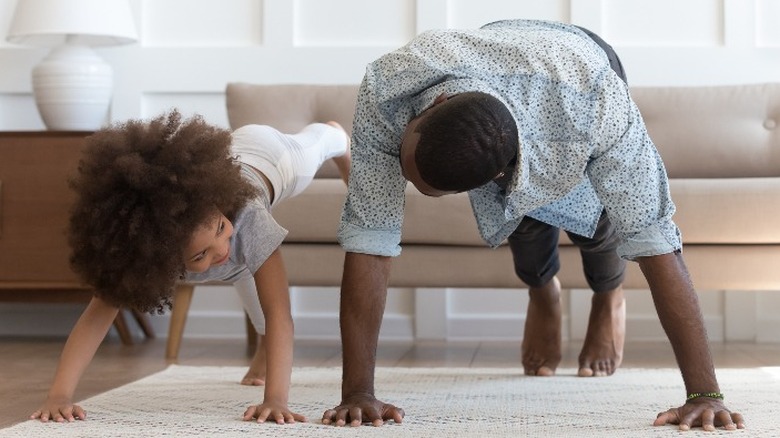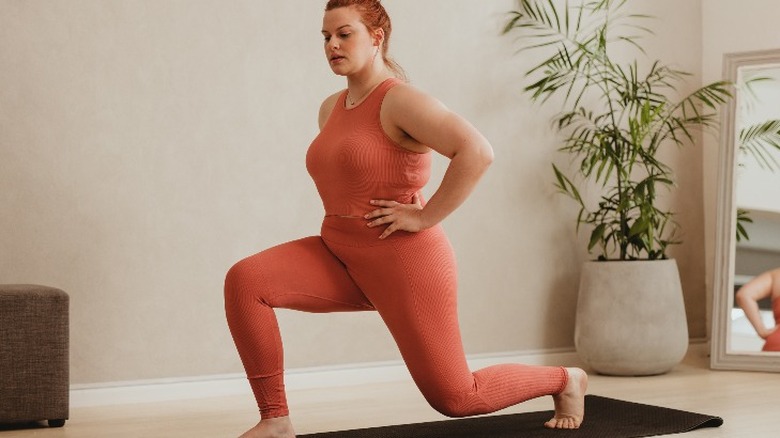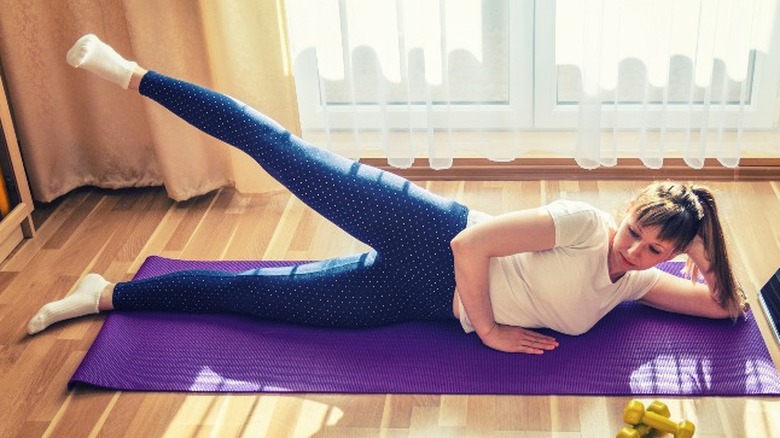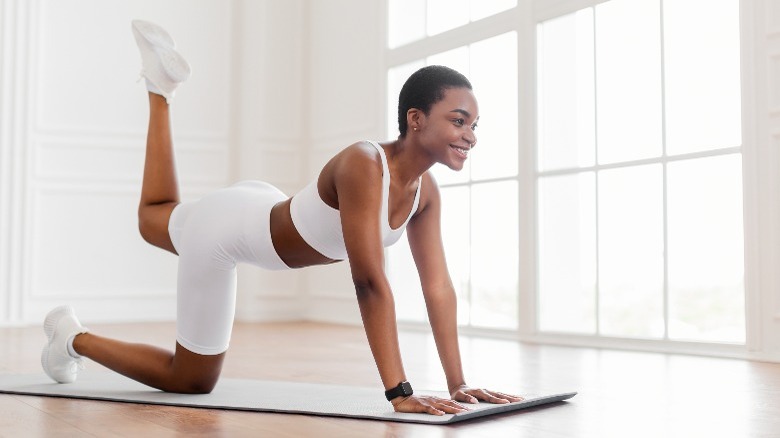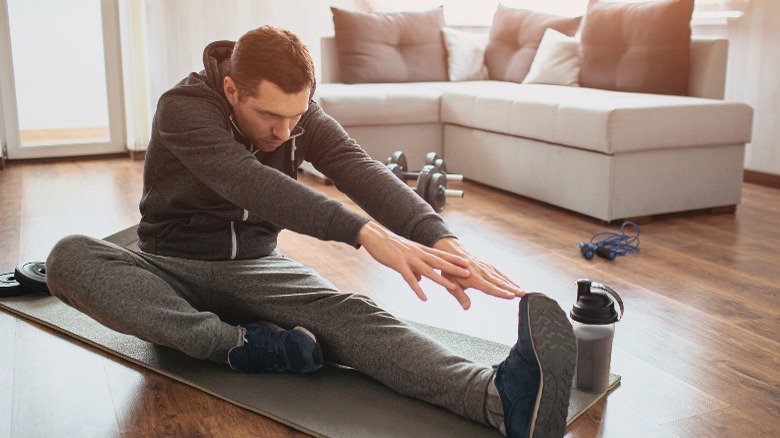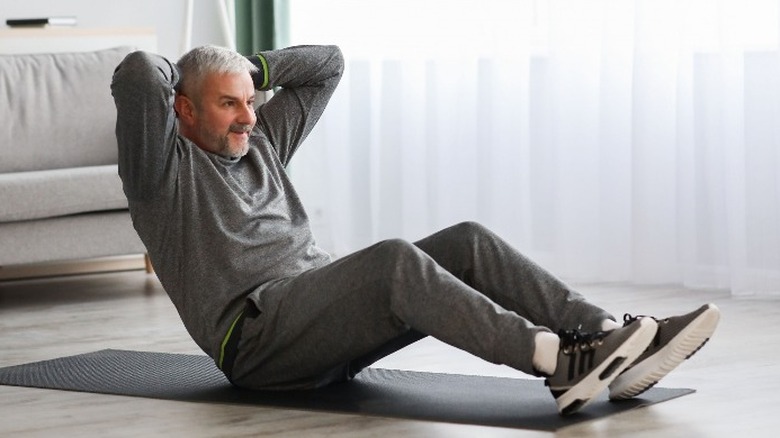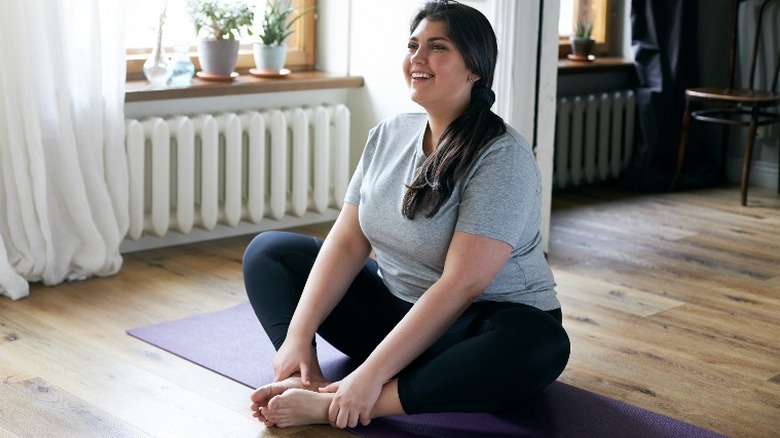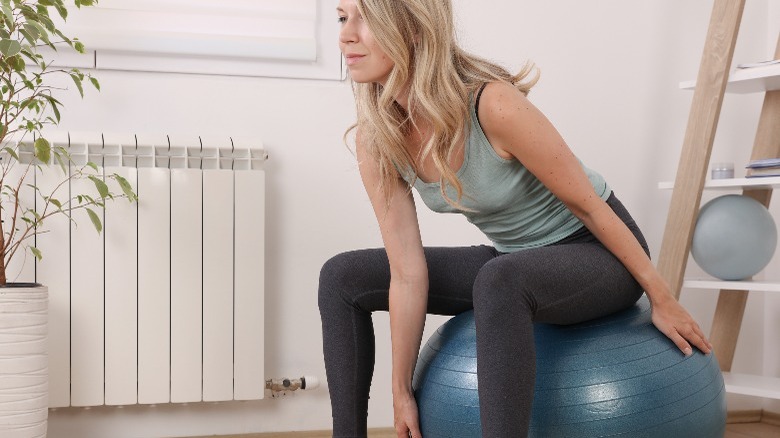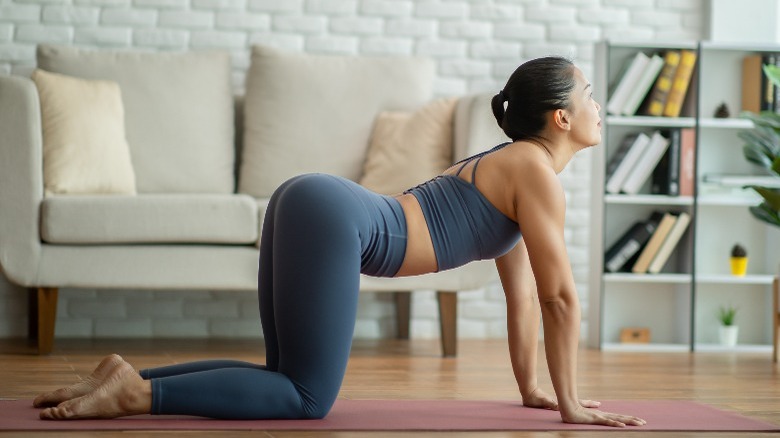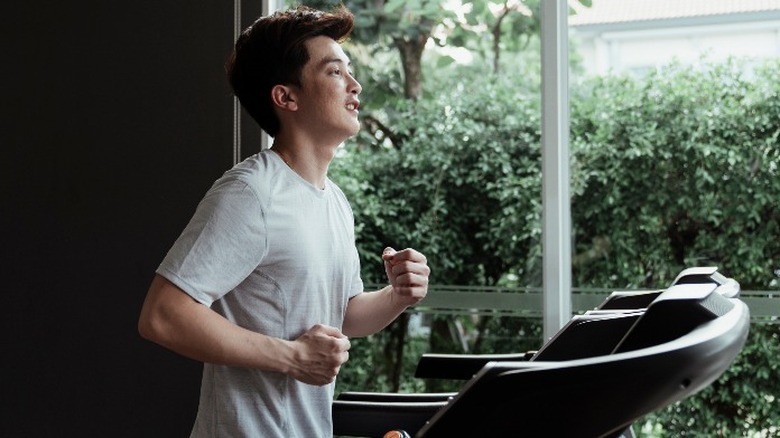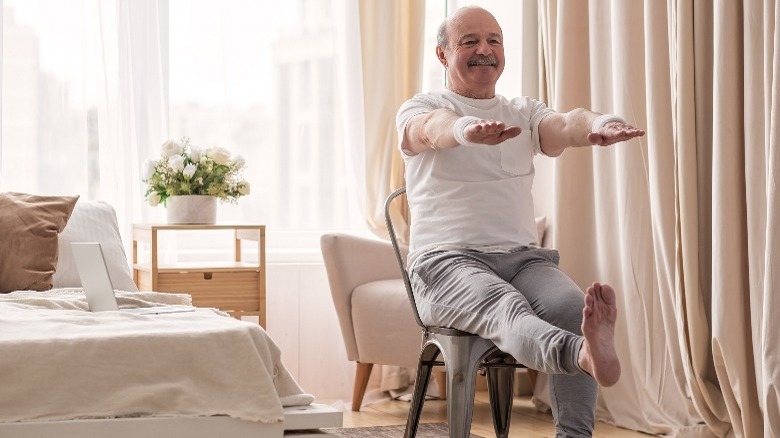Workouts You Can Do From Home While Watching TV
When daily routines are hectic and schedules are packed, it's difficult to find a moment to focus on yourself. This constant rush may leave you feeling torn between what you should do with the little time you have left at the end of the day. On the one hand, you want to relax and catch up on your favorite TV shows. On the other hand, you know you should really get a quick workout in to keep your health on track.
While it's tempting to kick your feet up and sink into the couch for a few hours, even just five minutes of physical activity can do a lot to boost your well-being. Exercise can have profound effects on your health, including a boost to brain function, weight management, bone and muscle strength, and immunity (per the Centers for Disease Control and Prevention). You can also reduce your risk of developing diabetes and some cancers when you get regular physical activity.
Rather than having to choose between watching TV or working out, why not do both? There are several types of workouts you can do while enjoying TV that can help get your blood pumping without missing a moment of your favorite show. Physical activity can also boost your mood and give you more energy, so it's worth squeezing a workout into your TV time.
Low-intensity cardio
One of the easiest exercise routines you can knock out while enjoying a movie or TV show is a low-intensity cardio workout. Unlike high-intensity exercises that involve vigorous physical activity done in shorter intervals, a low-intensity workout uses manageable aerobic movements done at a steady, comfortable pace that increases your heart rate enough to get benefits without leaving you breathless.
The one big difference between low-intensity and high-intensity training, however, is that you will need to do low-intensity exercises for longer periods to get the same results (per the American Council on Exercise). According to Healthline, these types of cardio workouts should typically last about 45 minutes to one hour. Although that might sound like a long time, it can go by quickly if you're distracted by the TV and keep your workout at a comfortable intensity level.
Some examples of exercises you can incorporate into your low-intensity steady-state (LISS) cardio workout include marching or running in place, light jumping jacks, shadow boxing, and step-ups if you have stairs or a bench that allows you to step up and down easily. Set a timer that repeats every few minutes and rotate between these movements.
Squats
As described by Live Science, squats are a type of compound exercise that targets the legs to strengthen muscles and improve posture, joint stability, and flexibility. Squats also burn fat and help you lose or maintain your weight, which is particularly beneficial if you're feeling guilty about that heavy meal you had earlier in the day. The best part about this rewarding exercise is you can do them anywhere and you don't need any equipment to knock them out — exactly what you need while watching TV.
Because there are different variations of squats, you can work on different parts of your legs to increase endurance and limit boredom as you tackle your workout. A basic squat is done by spreading your feet to about shoulder-width apart with your toes turned out slightly. Then, bend your knees while bringing your bottom towards the ground like you're sitting in an invisible chair until your thighs are parallel to the floor. Using your legs and keeping your back straight, push yourself back up to standing and repeat.
Other popular types of bodyweight squats include the wall squat, plié squat, prisoner squat, and side squat. These squat positions are all variations of the basic squat with subtle differences that get you moving in different planes of motion and focusing on other muscles.
Push-ups
If you want to work on your arms and chest while you watch TV, the classic push-up is the perfect exercise. Push-ups also target abdominal muscles, hips, and legs, which can give you a more comprehensive workout than most people realize. According to WebMD, doing push-ups can improve balance and posture, protect you from back injuries, and effectively burn calories — in addition to strengthening your upper body.
However, doing a push-up the right way does require you to keep your spine in alignment. If you're doing push-ups on the floor, it's important that you look down at the floor to keep your neck and spine in line while in the plank position. Because that can be difficult with the TV above you, it's a good idea to only do traditional push-ups during commercial breaks or in between the action.
You also have the option to modify your push-ups to make it easier to enjoy your favorite show or movie. For example, you can do push-ups while leaning against the back of your couch or a chair to keep your body aligned while having your eyes on the TV. Switching up your push-up form has other advantages as well. New York trainer Jackie Stalzer told SELF, "Not only is it a good idea to perform multiple types of push-ups to engage different parts of your body, but it's also important to explore your options to find out which variations work best for you."
Lunges
Lunges are another type of resistance exercise that doesn't require any equipment and uses your own body weight to strengthen and tone your lower body muscles. Healthline also explains that lunges are unilateral movements, which means they work one side of the body separately from the other as you alternate between your right and left legs. These types of exercises are especially good for improving balance, stability, and overall coordination.
A stationary lunge is the basic form of this exercise and a good starting point if you plan on adding this movement to your TV-watching workout. Mayo Clinic shares that you start by stepping one foot ahead of your body and bending your knee until it is at a 90-degree angle and not past your toes. You should also bend the knee of the other leg behind you until it is parallel to the floor. Always keep your back neutral with no twist or curve while performing this exercise to avoid injury and to correctly target the glutes, quadriceps, and hamstrings.
Other than the stationary lunge, there are other lunge movements you can mix into your exercise routine, including reverse lunges, curtsy lunges, and side lunges. Each variation brings a new dynamic to the movement, which can help tone the back muscles, calves, and abdominals.
Leg lifts
If you want to stay on the floor during your workout while watching TV, leg lifts are a powerful exercise you should consider. While simple leg lifts look like they might be easy, they actually work several major muscle groups that can transform your body when done regularly. Some leg lift exercises you can do in front of the TV include the double leg lift, single left lift, and side-lying leg lift.
To strengthen your core, lessen back pain, and improve posture, traditional leg lifts may be your best bet. These movements are especially helpful for those who spend a lot of time sitting. Exercise physiologist Griffin Nykor told Cleveland Clinic, "For office workers or other people who sit a lot, [leg lifts] can help to open up your hips to keep you limber to go through your day-to-day." While lying on your back, raise your legs up while keeping them together and not arching your back until they are perpendicular to the floor. You then slowly lower them to just above the floor before repeating the movement.
Side-lying leg lifts also target the core and leg muscles but in a different way. According to Gymless, side leg raises work the outer thighs, hip abductors, and obliques. You do these while lying on your side rather than your back with your head propped up by your arm. Raise your top leg up and down while keeping your back neutral and core engaged.
Donkey kicks
For many people, one of their main fitness goals is to tone and tighten their glutes. Your backside muscles can be tough to transform if you don't perform exercises that specifically target that area. Donkey kicks are one type of compound exercise that can help you get those sought-after results in your gluteal muscles.
Donkey kicks get their name because the movement mimics the way a donkey kicks its hind legs. With that in mind, you can imagine what this exercise looks like. You start in a neutral position on all fours. While keeping your hands on the floor and core engaged, lift one leg up with the knee staying bent and the bottom of the foot raising up towards the ceiling. Healthline recommends repeating the movement 20 times and doing four to five sets on each leg.
These movements can be challenging, especially for those who don't already have a basic fitness foundation. However, you can start slow and work your way up to more reps and sets as you gain strength and endurance. Because it's essential to focus on form with this exercise, consider doing your sets during commercial breaks or while watching something that doesn't distract you too much.
Leg stretches
Stretching your legs and lower body muscles is a great way to release tension and pressure after a long day. Although many workouts focus on improving strength and burning calories, there are other fitness elements that are equally important. Flexibility and mobility are two aspects of physical wellness that will help you avoid injury, increase your range of motion, and even improve blood flow to your muscles (per Mayo Clinic).
While watching TV, you can do different leg stretches that lengthen your muscles and keep you active. For example, a classic calf stretch is done while standing, and does not require you to move around very much. You simply step your right foot forward while your left foot is flat on the ground behind you. Gently bend your right knee until you feel a stretch in your left calf. Hold the position for about 20 seconds before switching legs and repeating.
You can also complete stretches for your hamstrings, hip flexors, quadriceps, and inner thighs for a good flexibility session that leaves you feeling limber and relaxed. However, be sure that you're not pushing yourself to a point of pain or bouncing as you stretch. These practices can lead to muscle damage or injuries (via Harvard Health Publishing).
Abdominal exercises
Another area many people feel particularly self-conscious about is the midsection. Although toning and tightening your core is a challenge, focusing your workouts to target your abdominal muscles can go a long way toward overall success. Many of these ab exercises can be done on the floor or without equipment, making them easy to knock out while watching a show or movie on TV.
Crunches are an effective and versatile way to help you get a toned core. While lying flat on your back with your feet planted on the floor and hip-distance apart, cross your arms over your chest (via Healthline). Engage your abdominal muscles and lift your upper body off the floor without straining your neck muscles. Slowly return to your original position and repeat the movement for several reps. You can also try different variations of crunches, including the bicycle crunch, reverse crunch, scissor crunch, and oblique crunch.
If you've always avoided abdominal exercises because you don't like traditional crunches, there are so many other movements that can strengthen your core and build that six-pack. Planks, mountain climbers, and torso twists are just some of the exercises you can rotate into your workout to help you tighten up your abs.
Sitting yoga poses
Rather than curling up on the couch or under your blankets to watch TV, there are some yoga poses you may want to try that have several physical and mental health benefits. According to Johns Hopkins Medicine, yoga can improve balance and posture, relieve muscle pain and tension, and boost your mood and energy levels. If you've had a stressful day, certain yoga poses can help reduce and manage stress levels, too.
You don't have to complete a rigorous yoga routine to reap some of these benefits. There are seated yoga positions that can help you shift your mindset and balance almost immediately. While staying grounded on the floor, you can begin with a staff pose, hero pose, or easy pose to open up your hips and stretch tired muscles (via Yoga Journal). If you're warmed up and want to challenge your flexibility a little more, the fire log pose, lotus pose, and wide-angle seated forward bend are additional positions to consider.
Stability ball exercises
If you have a stability ball at home, you can definitely take advantage of it while enjoying movie night or diving into the latest episode of a hit show. Stability or fitness balls are large inflatable balls designed to enhance workouts or provide support during physical activity (via MasterClass). Many people use a stability ball as an essential piece of workout equipment that helps them target their abs and other muscle groups or switch up their exercise routines.
Feeling bored with your workouts? A stability ball can ramp up just about any exercise, including those you do while watching TV. For example, a basic squat can become more challenging by adding the element of rolling the ball between your back and a wall as you squat down and up again. These stability ball squats require more focus on form to ensure you're doing them correctly and using the right muscles.
Other types of stability ball exercises include the hamstring curl, single leg lifts, and floor taps. They all require a combination of balance, strength, and flexibility to perform the movements, which means you're putting in the work without having to run to the gym. However, it's important to be careful during these exercises to reduce your risk of injury. You should already be comfortable using a stability ball if you're going to incorporate it into a workout while watching TV.
Arm weight training
Strong biceps and toned shoulders are something you can work on while indulging in a TV binge session at home. All you need is a set of dumbbells and a bit of motivation to complete enough reps that yield results. Depending on your strength training experience, you may want to start with a lower weight and build up to heavier dumbbells as your fitness levels progress.
The most basic arm exercise is the biceps curl, which involves raising and lowering dumbbells at your sides. You can complete this movement while standing or sitting as long as your back is straight and your core is engaged. While holding the weights at your sides, bend your elbows and use your biceps to curl the weight upwards to your shoulders. Hold that position for a few seconds before lowering them and repeating the movement.
Working your arms, shoulders, and upper body with weights can do more for your overall health than simply strengthening your muscles. As shared by the Huffington Post, lifting weights can improve heart health, posture, and bone strength. You can also lower your risk of suffering injuries and reduce the pain you experience if you are injured.
Back stretches
Another group of stretches you can do in front of your TV focus on the back muscles. Back stretches and exercises that strengthen those crucial muscles can provide much-needed relief for back pain and tension while supporting a better range of motion. If you're struggling with lower back pain or spend a lot of time sitting during the day, these back stretches are a good way to help your body bounce back.
According to Mayo Clinic, the knee-to-chest stretch is done lying flat on your back with your knees bent so your feet are pressed against the floor. Use your hands to pull one knee up and hug it into your chest for a few seconds while pushing your spine toward the floor. Then, return that leg to the starting position, switch to the other leg, and repeat. You can also incorporate some twisting stretches that rotate and lengthen the spine, including the lower back rotational stretch while lying down or in a seated position.
The cat-cow stretch is another beneficial movement that releases pressure and stress while easing back pain (via Healthline). Start on your hands and knees in a tabletop position. As you breathe deeply, alternate between curving your back up as you push your chest forward and rounding your spine and tucking your tailbone inward.
Treadmill walking
If you're lucky enough to have a treadmill at home, going for a brisk walk or easy jog on the treadmill is the perfect way to get a quick workout while watching TV. Your favorite show may provide just enough distraction to keep you from focusing too much on how tired you are or how long you've been going. In fact, a study published in the Journal of Sports Science & Medicine found that TV viewing makes moderate exercise more enjoyable for many individuals.
The study also concluded that the entertainment people watched while exercising also factored into their reported enjoyment of the workout. When participants were allowed to choose what they could watch during the session made it more enjoyable when compared to having no control over what they watched. The distraction element of TV was another confirmed benefit for several test participants who struggled without TV.
However, it's crucial to prioritize safety if you plan to watch TV while on the treadmill. This means keeping intensity levels moderate and knowing how to operate the machine. Also, if you want to ramp up your workout, it may be better to increase the treadmill incline versus speed. Personal trainer Holly Roser explained to Shape, "Walking on an incline is a full-body workout that can burn as many calories as you would while running [on a flat surface]."
Sitting exercises
For those who are new to working out or have limited mobility due to age or injury, sitting exercises can be a great starting point to get you moving. Modifying common exercises so they can be done in a sitting position makes working out more approachable and sustainable (via Medical News Today).
Some simple chair exercises you can do in front of the TV include simple knee extensions, ankle stretches, seated marches, arm raises, and core twists. As you become stronger and build confidence, you can progress to seated jumping jacks and sit-to-stand exercises that work the core, support bone health, and increase your heart rate (per GoodRx).
As always, it's important to speak to your doctor or other healthcare providers to see which types of exercises are appropriate for your fitness level. If you're recovering from an injury or have health issues that limit your ability to move or exert yourself, you need to do what's best for your body and overall recovery.

